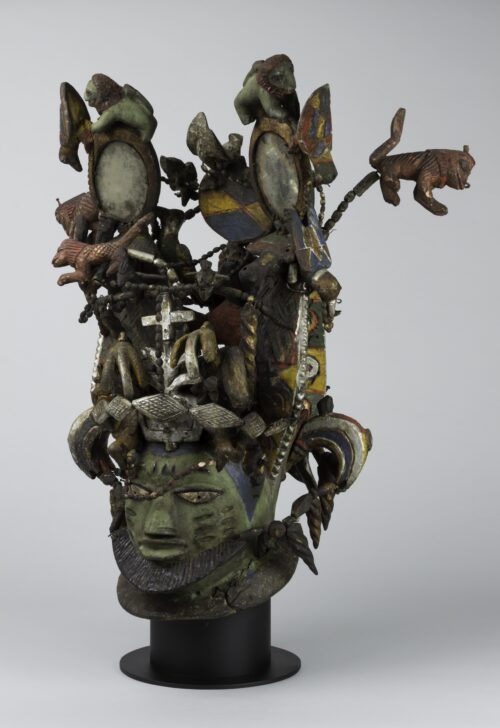Egúngún headdress
Workshop of Adugbologe

Description
March 28, 2009
Egúngún—meaning “power concealed”—is a masquerade performed to honor the spirits of important Yoruba ancestors. This marvelous headdress is worn with a voluminous costume made from layers of brightly colored cloth strips that billow and flare with the whirling rotations of the dancer: the spinning dance and the flaring attire communicated that the dancer had left the human realm and was manifesting the realm of the spirit. Distinguished by its large ears, it is called erin, or elephant, a metaphor for both the grandeur of its costume and the wealth of its owner.
This headdress is a veritable theater of symbols that allude to its history and might. Birds evoke “our mothers”—female elders and ancestors who possess both creative and destructive powers—while lions leap in likely reference to British heraldry. Medicine packs shaped like beaded lozenges and triangles, a Christian cross, and Qur’anic amulets testify to the intersection of religions in Yoruba culture. The beard, protective bird claws, and a double-headed drum used to praise and fortify hunters suggest this was a hunter’s Egúngún.
Subject Matter:
Egúngún – meaning “power concealed” – is a masquerade performed to honor the sprits of important Yoruba ancestors. This marvelous headdress is worn with a voluminous costume made from layers of brightly colored cloth strips that billow and flare with the whirling rotations of the dancer, the spirit manifest. Distinguished by its large ears, it is called erin, or elephant, named for both the grandeur of its costume and the wealth of its owner.
Physical Description:
A massive wood-carved headdress with stylized face (showing classic Yoruba features) of bulging eyes with defined upper lids, long, straight, triangular nose, symmetrical scarification patterns consisting of three horizontal lines on each cheek, and a short beard from ear to ear just underneath the lower lip. Two large “ears” protrude on either side of head and act as “scaffolding” for numerous attachments of symbolic content: birds and lions predominate, but also visible are amulets, wooden claws and beads, crosses, and an insignia shield of some kind. The ears terminate in two oblong mirrors with lions leaping off of each. Layers of pigment are visible, giving the impression that it has been repainted over time.
Usage Rights:
If you are interested in using an image for a publication, please visit https://umma.umich.edu/request-image/ for more information and to fill out the online Image Rights and Reproductions Request Form.